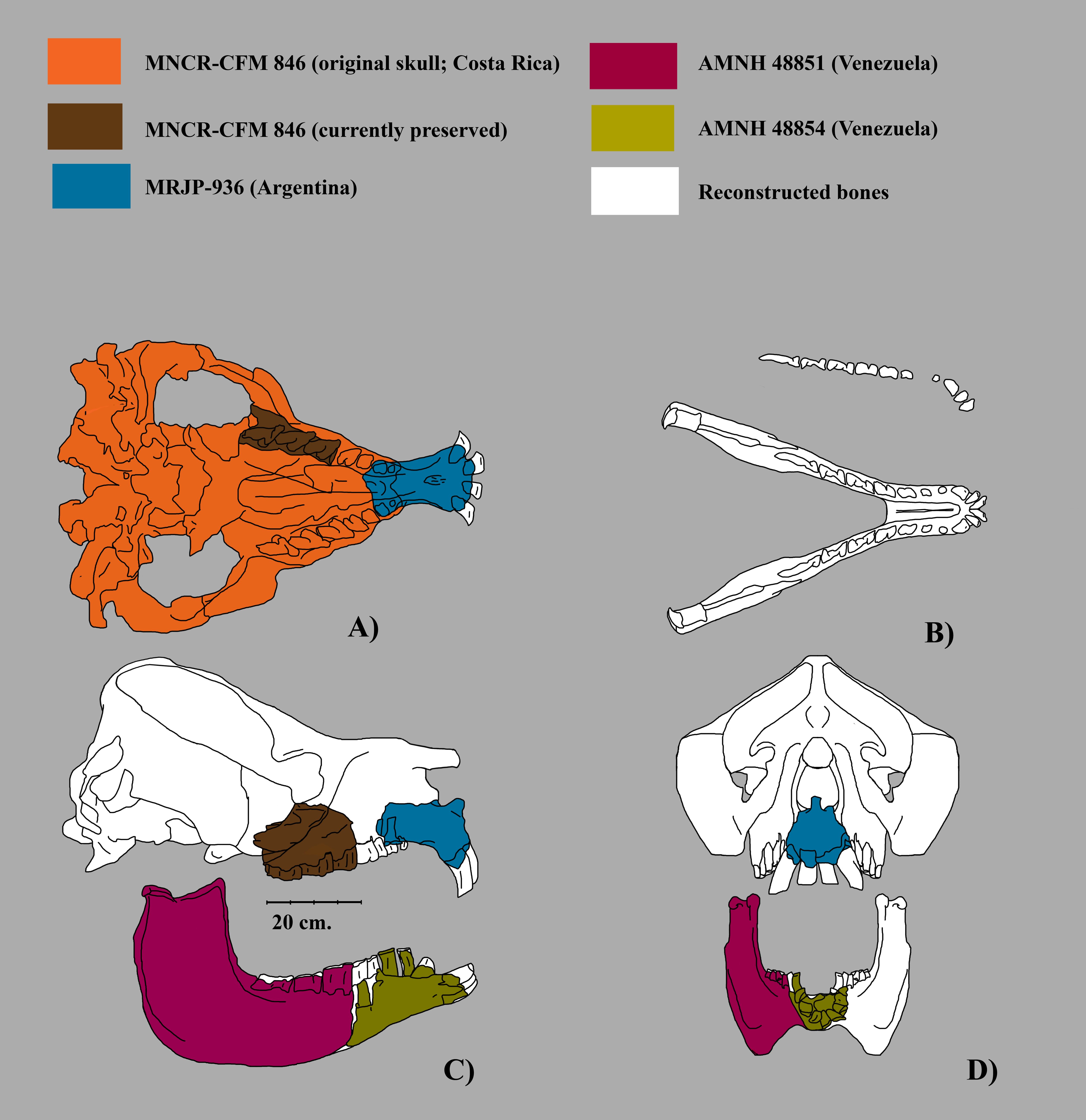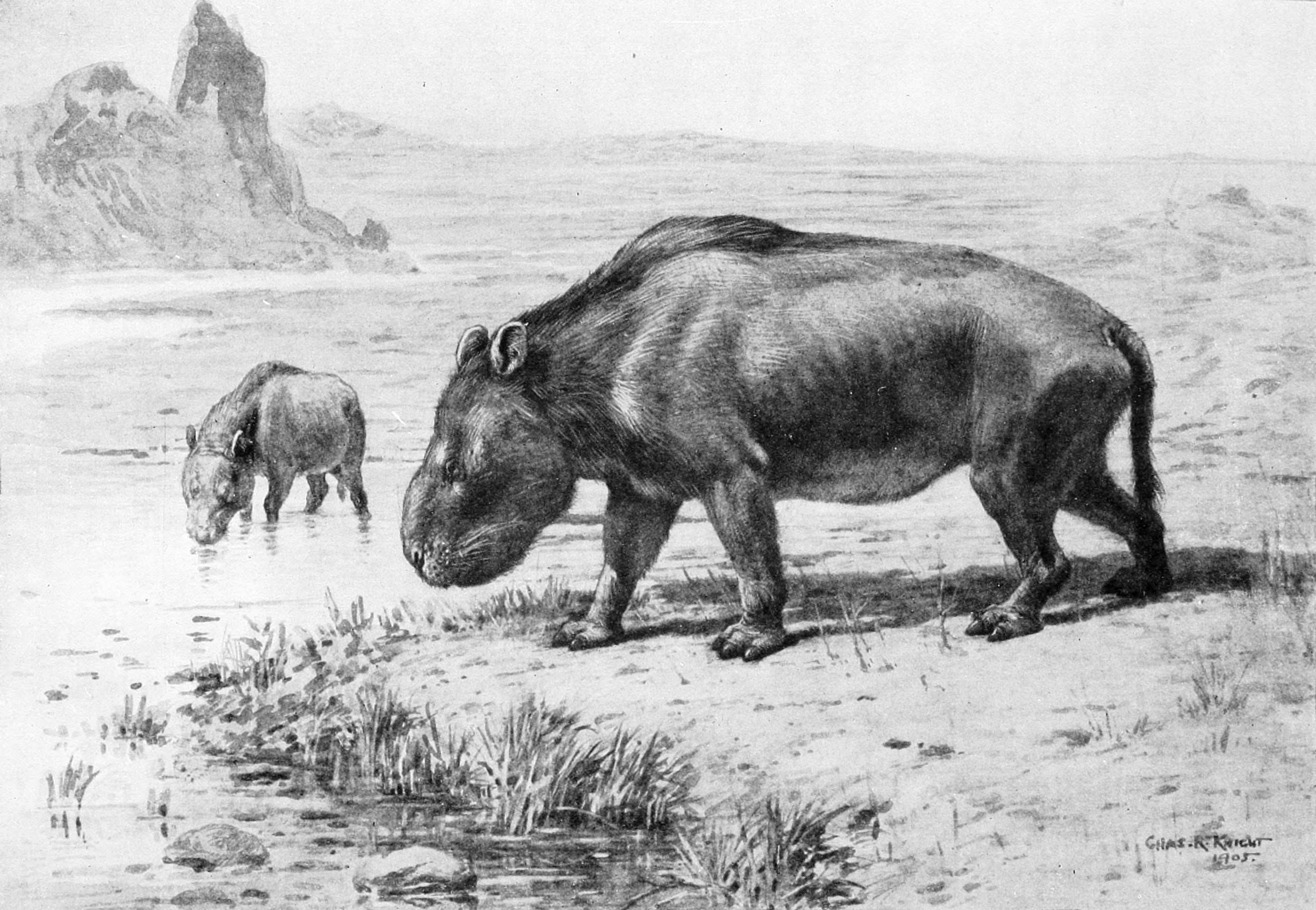|
Toxodontidae
Toxodontidae is an extinct family of notoungulate mammals, known from the Oligocene to the Holocene (11,000 BP) of South America, with one genus, ''Mixotoxodon'', also known from the Pleistocene of Central America and southwestern North America (Texas).E. Lundelius, et al. 2013. The first occurrence of a toxodont (Mammalia, Notoungulata) in the United States. ''Journal of Vertebrate Paleontology'', Vol 33, No 1, pp. 229–23DOI:10.1080/02724634.2012.711405/ref> They somewhat resembled rhinoceroses, and had teeth with high crowns and open roots, suggesting that they often fed on tough pampas grass. However, isotopic analyses have led to the conclusion that the most recent forms were grazing and browsing generalists. Taxonomy The endemic notoungulate and litoptern ungulates of South America have been shown by studies of collagen and mitochondrial DNA sequences to be a sister group to the perissodactyl Odd-toed ungulates, mammals which constitute the taxonomic order Perisso ... [...More Info...] [...Related Items...] OR: [Wikipedia] [Google] [Baidu] |
Deseadan
The Deseadan ( es, Deseadense) age is a period of geologic time (29.0–21.0 Ma) within the Oligocene epoch of the Paleogene to the Early Miocene epoch of the Neogene, used more specifically within the SALMA classification of South America. It follows the Tinguirirican and precedes the Colhuehuapian age. Etymology The age is named after the Deseado Formation of the Deseado Massif in eastern Patagonia, Argentina. Formations Fossils Correlations The Deseadan South American land mammal age (SALMA) is equivalent to the Arikareean in the North American land mammal age (NALMA) and the Harrisonian in the 2000 version of the classification. It overlaps with the Hsandagolian The Hsandagolian age is a period of geologic time (33.9 – 23.03 Ma) within the Oligocene epoch of the Paleogene used more specifically with Asian Land Mammal Ages. It follows the Kekeamuan and precedes the Tabenbulakian age. The Ulangochuian ... of Asia and the MP 25 zone of Europe, the Waitaki ... [...More Info...] [...Related Items...] OR: [Wikipedia] [Google] [Baidu] |
Mixotoxodon
''Mixotoxodon'' ("mixture ''Toxodon''") is an extinct genus of notoungulate of the family Toxodontidae inhabiting South America, Central America and parts of southern North America during the Pleistocene epoch, from 1,800,000—12,000 years ago.''Mixotoxodon'' at .org Description 
[...More Info...] [...Related Items...] OR: [Wikipedia] [Google] [Baidu] |
Toxodontinae
Toxodontidae is an extinct family of notoungulate mammals, known from the Oligocene to the Holocene (11,000 BP) of South America, with one genus, ''Mixotoxodon'', also known from the Pleistocene of Central America and southwestern North America (Texas).E. Lundelius, et al. 2013. The first occurrence of a toxodont (Mammalia, Notoungulata) in the United States. ''Journal of Vertebrate Paleontology'', Vol 33, No 1, pp. 229–23DOI:10.1080/02724634.2012.711405/ref> They somewhat resembled rhinoceroses, and had teeth with high crowns and open roots, suggesting that they often fed on tough pampas grass. However, isotopic analyses have led to the conclusion that the most recent forms were grazing and browsing generalists. Taxonomy The endemic notoungulate and litoptern ungulates of South America have been shown by studies of collagen and mitochondrial DNA sequences to be a sister group to the perissodactyl Odd-toed ungulates, mammals which constitute the taxonomic order Per ... [...More Info...] [...Related Items...] OR: [Wikipedia] [Google] [Baidu] |
Nesodon
''Nesodon'' ("island tooth")Palmer (1904) p. 457. is a genus of Miocene mammal belonging to the extinct order Notoungulata which inhabited southern South America during the Late Oligocene to Miocene living from 29.0 to 16.3 Ma and existed for approximately . It had a relatively large size, weighing up to 554 kg (1221 lbs) and reaching 1.5 m in height.D.Patterson, Bruce (2012) ''Bones, Clones, and Biomes: The History and Geography of Recent Neotropical Mammals'' p.92 Taxonomy ''Nesodon'' was named by Owen (1846). It was assigned to Toxodontidae by Carroll (1988). It was an early member of the family Toxodontidae, which included the well-known Pleistocene genus ''Toxodon''. Like almost all toxodontids, ''Nesodon'' was endemic to South America. In particular, fossils of ''Nesodon'' are known from late early Miocene ( Santacrucian SALMA) deposits of Argentina and Chile.Croft et al. (2004), p. 5. Three species of ''Nesodon'' are recognized including a larger spec ... [...More Info...] [...Related Items...] OR: [Wikipedia] [Google] [Baidu] |
Nesodontinae
Toxodontidae is an extinct family of notoungulate mammals, known from the Oligocene to the Holocene (11,000 BP) of South America, with one genus, ''Mixotoxodon'', also known from the Pleistocene of Central America and southwestern North America (Texas).E. Lundelius, et al. 2013. The first occurrence of a toxodont (Mammalia, Notoungulata) in the United States. ''Journal of Vertebrate Paleontology'', Vol 33, No 1, pp. 229–23DOI:10.1080/02724634.2012.711405/ref> They somewhat resembled rhinoceroses, and had teeth with high crowns and open roots, suggesting that they often fed on tough pampas grass. However, isotopic analyses have led to the conclusion that the most recent forms were grazing and browsing generalists. Taxonomy The endemic notoungulate and litoptern ungulates of South America have been shown by studies of collagen and mitochondrial DNA sequences to be a sister group to the perissodactyl Odd-toed ungulates, mammals which constitute the taxonomic order Perisso ... [...More Info...] [...Related Items...] OR: [Wikipedia] [Google] [Baidu] |
Charruatoxodon
''Charruatoxodon'' is an extinct monotypic genus of notoungulate belonging to the family Toxodontidae. It lived from the Pliocene to the Early Pleistocene in what is now southern Uruguay. Its remains have been found in the San José member of the Raigón Formation, near Montevideo. History The holotype of the genus, FC-DPV-514, was described in 1842 by Alcide d'Orbigny and Charles Léopold Laurillard, who assigned it to the species '' Dinotoxodon paranensis''. They believed the specimen to come from the Upper Miocene Camacho Formation. The assignation to the species ''D. paranensis'' was contested by Pérez-García in 2004, who only assigned it to the genus ''Dinotoxodon''. In 2013, a study by Perea, Rinderknecht, Ubilla, Bostelmann and Martinez assigned it as Toxodontidae indet., and estimated its remains to be more recent than initially thought, likely the result of the fall of a overlying block containing the remains inside an earlier deposit, and assigned it to the Monteh ... [...More Info...] [...Related Items...] OR: [Wikipedia] [Google] [Baidu] |
Proadinotherium
''Proadinotherium'' is an extinct genus of toxodontid. It lived between the Late Oligocene and the Early Miocene in what is now South America. Description This genus is only known from very partial remains. From the comparison with its relatives '' Adinotherium'' and ''Nesodon'', it is supposed that ''Adinotherium'' was an herbivorous animal the size of a sheep, with an elongated body and rather short legs ; it was probably more slender-built than the two latter forms. The legs, in particular, had more delicate and slender bones than those of ''Adinotherium'' and ''Nesodon''. ''Proadinotherium'' was characterized by its teeth with a lower crown, less hypsodont than those of ''Adinotherium'', but evocating more derived toxodontids. Its dentition was complete with a complex structure, and the development of a crest on the molars. Classification ''Proadinotherium'' is considered to be the most basal and oldest member of the Toxodontidae, the most specialized group of the notoungul ... [...More Info...] [...Related Items...] OR: [Wikipedia] [Google] [Baidu] |
Falcontoxodon
''Falcontoxodon'' is an extinct genus of toxodontid notoungulate that lived from the late Pliocene to the Pleistocene in what is now Venezuela. Fossils of this genus have been found in the Chapadmalalan-Uquian Codore Formation, as well as in the more recent Ensenadan San Gregorio Formation. Description The genus ''Falcontoxodon'' was described in 2018 by Carrillo ''et al'' with AMU-CURS 765, an almost complete skull with a well-preserved dentition found in the Algodones Member of the Codore Formation. In the same article, two other specimens assigned to ''Falcontoxodon'' were described from the Vergel Member of the San Gregorio Formation, assigned respectively to ''Falcontoxodon'' aff. ''aguilerai'' and ''Falcontoxodon'' sp. In 2021, an analysis of the San Gregorio Formation by Carrillo-Briceño ''et al'' uncovered thirty-three additional remains, mostly teeth, that were assigned to the genus. The name of the genus, ''Falcontoxodon'', refers to its relative, ''Toxodon'', an ... [...More Info...] [...Related Items...] OR: [Wikipedia] [Google] [Baidu] |
Palyeidodon
''Palyeidodon'' is an extinct genus of mammal belonging to the family Toxodontidae, from the Miocene of Argentina Argentina (), officially the Argentine Republic ( es, link=no, República Argentina), is a country in the southern half of South America. Argentina covers an area of , making it the second-largest country in South America after Brazil, th .... It contains the single species ''Palyeidodon obtusum''. References {{Taxonbar, from=Q110461397, from2= Toxodonts Miocene mammals of South America ... [...More Info...] [...Related Items...] OR: [Wikipedia] [Google] [Baidu] |
Adinotherium
''Adinotherium'' (meaning "not terrible beast")Palmer (1904) p. 80. is an extinct genus of Toxodontidae, large bodied hoofed ungulates which inhabited South America during the Middle to Late Miocene, from 17.5 to 6.8 Ma and existed for approximately , Santacrucian to Huayquerian in the South American land mammal ages (SALMA). Fossils of ''Adinotherium'' have been found in the Santa Cruz and Ituzaingó Formations of Argentina and the Chucal and Río Frías Formations of Chile.''Adinotherium'' at .org Description [...More Info...] [...Related Items...] OR: [Wikipedia] [Google] [Baidu] |
Gyrinodon
''Gyrinodon'' is an extinct genus of toxodontid notoungulate that lived from the Late Miocene and Early Pliocene in what is now Brazil and Colombia. Description This animal was approximately the size of a modern rhinoceros, and they were similar in build as in appearance. Like most of its close relatives, ''Gyrinodons size was substantially larger than any other mammal in its habitat. The frontal region of the skull passed softly into the anterior portion of the temporal fossa. The postorbital processes were reduced. Unlike some of its relatives, neither the upper edge of the orbit nor the roof of the nasal cavity were swollen. The lateral upper incisors were curved, and formed an arch of 180° or more. The first two upper molars had a small metaloph, while the third molar had a long and concave ectoloph, but was devoid of metaloph. The symphysis of the mandible did not exceed the second lower molar. The third lower molar lacked a second posterior crease in the enamel of the li ... [...More Info...] [...Related Items...] OR: [Wikipedia] [Google] [Baidu] |



